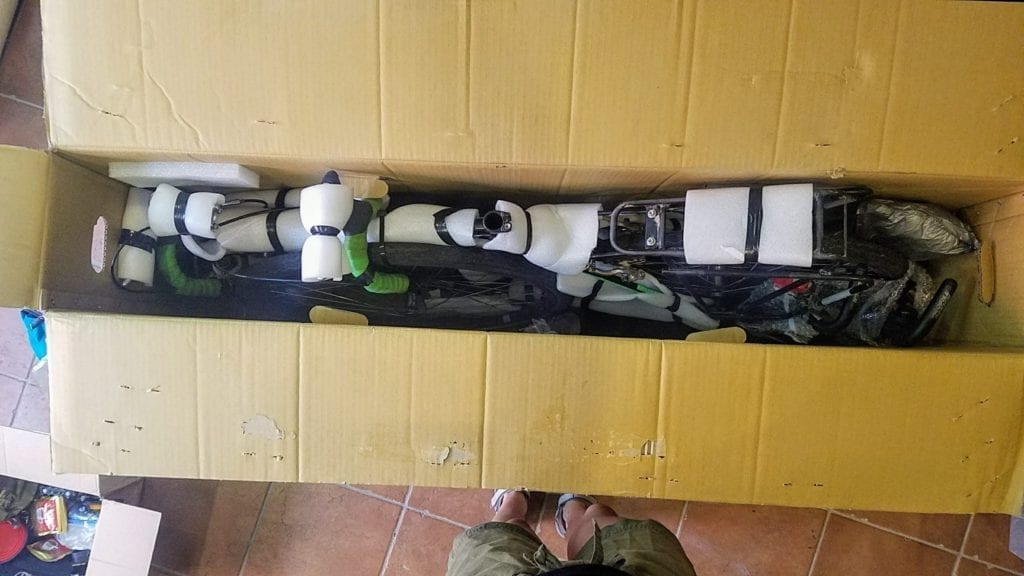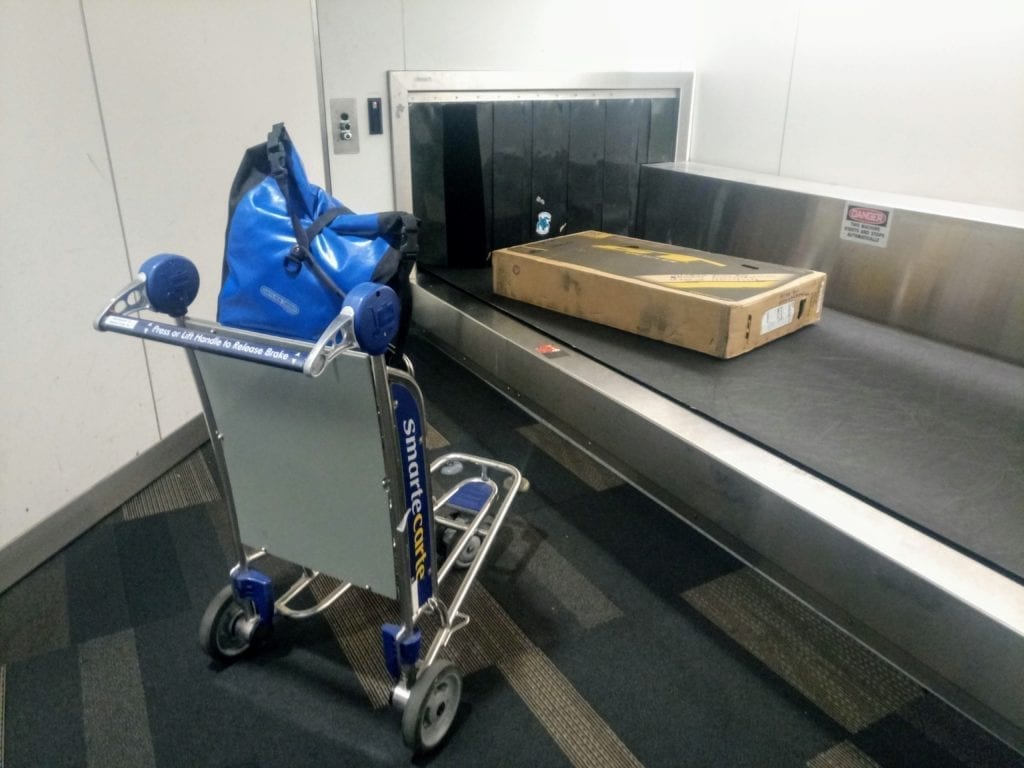Are you heading out of town for a bike race, event, vacation, or tour? Lucky you! We all know bikes are awesome and travel is fun, and travel with bikes is just the best thing ever.
But first, a decision: How should you get your bike there? Generally you have two options: ship your bike or fly with it as checked luggage. Both are perfectly good choices and usually work out well, but they do each have some unique pros and cons.
I’ve shipped my bike a few times and flown with it many times. To me shipping feels like the organized, predictable, civilized option. If you like to plan carefully, are usually packed a couple days before your flight, are flying to a place with good infrastructure, and want to know exactly what to expect, then shipping may suit you better. Flying with a bike can feel a bit stressful, uncertain, and sweaty (as you drag your bike box through the airport) but requires a bit less planning, is often cheaper, and generally works out fine in the end.
Which one is best for you? Besides these vibe differences there are some important practical issues to be aware of when choosing to ship versus fly with your bike. Read on and I’ll break it all down for you.
Related: How to Fly With a Bike as Checked Luggage

The bikes made it, yay!
When you buy through affiliate links in this post, I may earn a small commission. Thanks for your support! I always offer unbiased opinions based on real experience from the road and trail. Learn more.
Shipping Your Bike
When you ship your bike you pay a carrier like UPS or Fedex (ideally through a service like BikeFlights or ShipBikes, more on this below) to transport your bike box. Shipping your bike definitely removes hassle from your flight experience but adds some logistics decisions on either end. You can either arrange a pickup (usually free) or drop your bike box at a UPS store, and you’ll need to arrange a delivery address on the other end.
While you could ship your bike directly through the carrier, it’s best to use a bike-specific service like BikeFlights or ShipBikes. These services utilize UPS in the background but offer an additional layer of smoother user experience, customer support, monitoring, and insurance. They also offer lower rates, presumably through negotiations with carriers. According to a quick search, shipping a bike from California to Arizona would cost about $120 via UPS ground when booked directly with UPS, and only about $60 through BikeFlights.
Is it cheaper to ship your bike versus flying with it? That depends on many factors including airline, box size and weight, and your destination. The cost of shipping a bike within the US is fairly reasonable, often less than $100. This is cheaper than the least bike-friendly US airlines but more expensive than the most bike-friendly airlines (like Alaska) that waive overweight and oversize fees for bikes.
What about flying internationally? BikeFlights serves around 60 countries, which covers many destinations but definitely not all. Shipping internationally is likely more expensive than flying, but could be comparable in some cases if you’re stuck with a very bike-unfriendly airline. For example, a quick search on BikeFlights shows rates from California to Paris, France for under $300.
I’ve shipped my bike twice within the United States and really enjoyed not having to deal with my bike at the airport. The price was reasonable and it felt like a big luxury! To me shipping feels like the organized, predictable, more “civilized” option. If you like to plan carefully, are usually packed a couple days before your flight, are flying to a place with good infrastructure, and want to know exactly what to expect, then shipping may suit you better than flying with your bike.

Unboxing a bike that’s been carefully packed for shipping.
Advantages of Shipping Your Bike
Airport transportation is easier and cheaper: Depending on how you plan to get to and from the airport, the extra hassle and cost of a vehicle large enough to fit a bike box can totally cancel out the savings from flying with your bike. If there’s any question about whether your airport transportation can fit your bike box, shipping removes a lot of travel-day stress.
Hassle-free airport and flight experience: Getting your bike box to the airport, dragging it through the check-in line, potentially quibbling over the airline’s bicycle policy with the employees, and waiting anxiously at the oversize luggage pickup all add hassle and stress to your trip. Though it usually goes smoothly, I always allow lots of extra time because I worry about last-minute problems. Shipping your bike makes for a smoother airport experience.
Sometimes cheaper than flying: If you’re stuck flying on an airline with unfavorable bike policies, you could end up paying more to check your bike as luggage than to ship it. Shipping can also be cheaper if your bike box is heavier than common airline weight limits (often around 50 pounds).
Pricing is simple and clear in advance: Though most airlines publish their bicycle fee policies, it takes work to understand how all the weight, size, and checked bag limits add up especially on more complicated itineraries. Your shipping quote will come with a clear price based only on weight and size.
Weight and size limits are not as rigid: Many airlines have strict weight and size limits on bike boxes, and going over leads to a substantial fee. When shipping your bike the price does go up for bigger and heavier boxes, but the increase is incremental and predictable. You won’t need to hold your breath in anticipation as the airline employee weighs your box to see if their scale reads the same as your bathroom scale at home.
You can add extra insurance coverage: Bike shipping services like BikeFlights offer extra insurance coverage at reasonable rates in case of loss or damage.
You can ship e-bikes: Though details vary by bike and airline, flying with an e-bike is often prohibited due to the batteries. With UPS ground shipping this is not an issue, so shipping may be your only option if traveling with an e-bike.
Drawbacks of Shipping Your Bike
Need to arrange a shipping location: When shipping your bike you need to arrange a physical address for its destination, unless you want to pick it up from a UPS Customer Center instead (difficult if you don’t have transportation). This could be a home, hotel, Airbnb, office, bike shop, or other business, but it’s essential that you contact them first to make sure they’re willing and able to accept your package. For certain levels of insurance a signature will be required, and you probably don’t want your bike sitting out unattended in front of a home or business anyway.
Takes longer: Whey flying with a bike, if all goes well your bike spends the same amount of time in transit as you do. When shipping your bike even the fastest service takes one or two days, and longer distances can take up to five or six days. You’ll have to factor this into your travel planning.
Arrival time is uncertain: Delivery estimates usually span several days. If your bike absolutely must be there by a certain date, you’ll have to send it early enough. And whoever receives your delivery must be able to deal with timing uncertainty.
Bike needs to be ready before you leave: Because you’ll usually want your bike to be there when you arrive, you’ll need to ship it out before you leave home. This requires a bit more planning and forethought, and you’ll have to resist last-minute fiddling and gear list changes. When flying with a bike, by contrast, the bike leaves when you leave. You have a bit more time to prep and can make last minute additions or subtractions to the box all the way until you check it in at the airport.
Not the least-expensive method: While shipping your bike can be cheaper than flying if you’re stuck with a bike-unfriendly airline, it’s almost always possible to find a cheaper alternative by choosing your airline carefully.
Packing requirements may be stricter: Some airlines have very strict policies about how a bike must be packed, but some don’t. I’ve successfully flown with my bike in makeshift DIY “boxes” that would never be accepted by UPS or Fedex, not that I would have wanted them to anyway (see next point).
Potentially higher damage risk? Based solely on my own experiences shipping and flying with bikes, I feel the risk of damage is higher with shipping. If you’re going to ship, be sure to pack your bike very carefully. Both times I’ve shipped my bike there was damage (not catastrophic, but inconvenient) apparently caused by a hard impact to the side of the box. By contrast I’ve flown with my bike 15 times and never (knock wood) had an issue.
Bike is out of your hands for longer: This is mainly just psychological, but you’ll have to part with your trusty steed for longer if you ship it. When flying you’ll just be separated for the length of the flight and you’ll be on the same plane.
Flying With Your Bike
This might sound surprising if you haven’t done it before, but you can fly with a bicycle as checked luggage on an airplane. It’s usually considered oversize luggage, but many airlines have specific policies for bikes and other sports equipment and some will waive overage fees. You might need to pay anywhere from nothing to a couple hundred dollars to fly with your bike, depending on the airline and itinerary.
Flying with a bike can feel a bit stressful, uncertain, and sweaty (as you drag your bike box through the airport) but requires less planning than shipping, is often cheaper, and almost always works out fine in the end. I’ve flown with my bike at least fifteen times while traveling for bikepacking trips, often to places where shipping isn’t even a viable option like Vietnam, Kyrgyzstan, or Sudan. I also fly with my bike within the US regularly. Read on to learn how it compares to shipping.

Advantages of Flying With Your Bike
Often the cheapest option: If finding the cheapest option is important to you, you’ll probably want to fly with your bike as checked luggage. Shipping can be cheaper in some cases, but it’s usually possible to find a bike-friendly airline that waives overweight and oversize fees for bikes. In this case you’ll just pay the normal checked bag fee, which for domestic flights is often about $30.
Available everywhere: Though BikeFlights says they cover over 60 countries, that still leaves plenty of countries you can’t ship your bike to, including many popular destinations for bicycle tourers and bikepackers. Even when a country is covered the cost of international shipping is usually higher than flying, and reuniting with your bike on the other end may be more complicated in a foreign country.
No need to prep your bike days before you leave: When I travel for a bikepacking trip I’m usually fiddling with my bike and optimizing my gear list until the very last minute. When shipping your bike you’ll need to send it out a few days before you leave to make sure it’s there when you arrive. It’s totally doable, but might take some focused effort if you’re a last-minute packer.
No need to arrange a delivery address: With shipping you need a reliable delivery address to accept your package. This usually isn’t too hard — it can be a hotel, friend’s house, bike shop, etc. — but it does need to be arranged in advance and you need to trust that your bike won’t be left sitting outside on the curb. For some types of travel it’s hard to arrange this kind of reliable delivery and you’re better off keeping your bike with you as you fly.
More flexible: If you’re a bicycle traveler accustomed to seat-of-the-pants planning, you may prefer to fly with your bike for the flexibility. If you’re the type to build your bike at the airport, stop by the convenience store, and pedal straight out of town to the first campsite on your bikepacking route, flying is best for you.
Potentially looser requirements for packing: Some airlines have strict requirements for packing, but some will accept a makeshift DIY bike box made from cardboard scraps (check their policy first) that shipping services probably won’t accept.
Less risk of damage than you might think: I don’t want to make sweeping statements here, because some people have had their bikes damaged by airline baggage handlers. But in the 15 times I’ve flown with my bike I’ve never had an issue (knock wood), and I believe the baggage handlers generally try to be careful with bike boxes and cases. I have, on the other hand, experienced damage when shipping my bike, though this could have been bad luck.
Your bike stays with you: Though purely a psychological consideration, you might appreciate not having your bike out of your hands for several days.

That moment of relief when your bike arrives at the oversize baggage claim…
Downsides of Flying With Your Bike
Airport transportation may be more expensive and stressful: Depending on how you plan to get to and from the airport, a bike box can add cost and complexity. I’ve had a few moments of panic when my airport shuttle turned out to be a small minivan (“You’re telling me these boxes are somehow going to fit in there?”) but somehow we’ve always managed to fold down some seats and make it work.
You need to allow extra time at the airport: Dragging a bike box to the check-in counter, waiting in line, and sometimes clarifying policies with airline employees adds time to your airport experience. If you’re on a tight schedule and can’t allow extra time, shipping may be best.
Sense of uncertainty and stress: I’ve flown with my bike at least 15 times and it’s always worked out, but every single time I breathe a sigh of relief when the bike box is finally checked in. Sometimes airline employees aren’t familiar with their bicycle policies or need to contact a supervisor to verify fees and weight limits, which takes time and can lead to stressful moments.
Rigid size and weight limits: Every airline has its own policies, but often there’s a weight limit (sometimes 50 pounds) that you must not exceed or you’ll be slapped with a hefty overweight fee. When shipping a bike you’ll also pay more for larger and heavier boxes, but the difference is usually incremental.
Complicates the process of choosing a flight: There’s already enough to figure out when booking a flight as you try to find the best balance of cost, timing, layovers, etc. When you need to also factor in each airline’s bike policy and weight and size limits, you have to do some research and there’s even more to keep track of. I’ve even resorted to spreadsheets at times!
You usually can’t fly with an e-bike. In addition to breaking typical weight limits, e-bikes are often prohibited on planes due to their batteries.
Missed flights can be very inconvenient. Depending on your travel plans, a missed flight that leads to delayed luggage can be extra difficult when traveling with a bike. With shipping your bike takes a bit longer to get there but is highly likely to arrive within the scheduled timeframe.
Packing Your Bike for Shipping or Flying
You might be wondering which types of bike containers can be used for both shipping and flying. Each airline and carrier has their own policies, but usually the options are similar for both shipping and flying: cardboard bike boxes, hard-sided cases, or soft-sided cases.
Sometimes airlines are more forgiving than shipping carriers when it comes to packaging. A few airlines don’t require any box at all for flying with a bike, though this is rare (check the airline policy carefully). There have been times when I couldn’t find a bike box to return from a point-to-point trip, so I’ve made my own from cardboard scraps and the airline has accepted it. I highly doubt this would have worked with UPS. On the other hand, when shipping a bike you’re probably in an infrastructure-rich area where finding a bike box isn’t difficult.

Pretty sure UPS would not have accepted this bike box, but then again UPS wasn’t an option when flying home from Khartoum.
If you’re using a cardboard bike box, you can often get one for free or cheap from a local bike shop. Usually they just recycle them and are happy to give you one. If that’s not an option, both BikeFlights and ShipBikes sell cardboard bike boxes and will deliver them to your door, but they’re pretty expensive (especially BikeFlights). ShipBikes won’t accept any cardboard boxes besides their own, per a new policy, which is kind of a bummer.
Whichever box or case you choose, you’ll pack your bike similarly for either flying or shipping. Learn more about how to pack your bike here.
Which is Best?
Are you still trying to decide between shipping your bike and flying with it? They’re both great options. I suggest you play with the rate calculators at BikeFlights and ShipBikes and look at airline policies to see what kind of costs you’re dealing with. If you have the flexibility to choose your airline based on their bike-friendly policies, you can likely save a bit of money by flying. If you’re stuck with a bike-unfriendly airline, consider shipping, especially for relatively short distances.
Ask yourself which is harder for you to arrange: bike-friendly airport transportation (go with shipping in this case), or a reliable delivery address and someone to receive your bike box on delivery (go with flying).
Also think about what kind of airport experience you want. Flying with a bike for the first time can be stressful, but don’t let that keep you from trying it. It’s actually not bad as long as you can leave enough extra time at the airport. But if you already expect a time-constrained or stressful flight situation, shipping your bike can give you peace of mind. It’s also helpful if you’re traveling solo and worried about wrestling a heavy bike box through the airport by yourself.
For some specific cases like e-bikes, extra-large bikes, or extra-heavy bikes, shipping may be the best or only option. But you’ll need to check each airline’s policy to know for sure.
Whatever you choose, pack your bike carefully and do it early enough that you have time for any last-minute tweaks. The packing process always takes a bit longer than I expect, even with plenty of experience.
Last but not least, enjoy your ride once you reach your destination! It might seem like a ton of work to get yourself and your bike there safely, but I promise it’ll all be worth it in the end.
More Bike Resources
If you found this article helpful, you might also like these:
Or visit the cycling and bikepacking sections for lots more.
About the Author
Hi there, I’m Alissa, founder of Exploring Wild. I’ve traveled over 19,000 miles by bike and still can’t stop planning my next ride (and helping you plan yours). Pavement and panniers or singletrack and seat bag, I love it all. On my bike I feel free. Learn more about me here.
Shop Bikepacking Resources
digital help with planning, riding, and problem solving
Bike resources in your inbox?
There’s more where this came from! Sign up here for occasional emails full of inspiration and information about bikepacking and bicycle touring.
Share the Adventure
If you found this article helpful, please consider sharing so more people can benefit from it:
The post Shipping vs. Flying With Your Bike: Key Differences to Consider appeared first on Exploring Wild.
https://exploringwild.com/ship-vs-fly-with-bike/?utm_source=rss&utm_medium=rss&utm_campaign=ship-vs-fly-with-bike
 CampingSurvivalistHuntingFishingExploringHikingPrivacy PolicyTerms And Conditions
CampingSurvivalistHuntingFishingExploringHikingPrivacy PolicyTerms And Conditions
